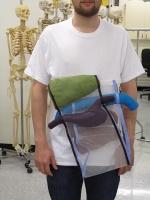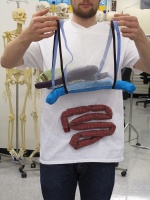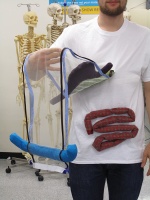Peritoneum T-Shirt: Difference between revisions
(Created page with "A T-Shirt model to demonstrate greater and lesser omentum to first year health science students. <gallery mode="nolines" widths=400px heights=400px> PeritoneumShirt04.jpg| </g...") |
No edit summary |
||
| Line 1: | Line 1: | ||
A T- | A T-shirt model to demonstrate greater and lesser omentum to first year health science students. | ||
<gallery mode="nolines" widths=400px heights=400px> | <gallery mode="nolines" widths=400px heights=400px> | ||
PeritoneumShirt04.jpg| | PeritoneumShirt04.jpg| | ||
Latest revision as of 02:45, 26 June 2018
A T-shirt model to demonstrate greater and lesser omentum to first year health science students.
Production Information
Materials: a large T-shirt, tulle (aka fine bridal netting), 4 pieces of woven fabric in different colours, dacron fill, two colours of bias binding, sew-in velcro. The background grid in the pattern photo is 100mm x 100mm.
Fabric models of the liver, stomach and transverse colon were made and stuffed with dacron. A small intestine model was made in a similar way but with an additional layer of tulle. The two pieces of tulle for the peritoneum had their long edges bound with coloured bias binding. The two layers were sewn through to make pockets for the liver, stomach and transverse colon. The tulle was then sewn to a T-shirt and velcro sewn on to the end of the tulle and on to the T-shirt. The small intestine model was sewn directly onto the T-shirt.
Creators: Associate Professor Beulah Leitch (initial idea and academic support), Fieke Neuman (patterns, sewing). All from Department of Anatomy, University of Otago.
Keywords: Teaching, Anatomy, Medicine, Abdomen, Peritoneum, Omentum, Mesentry, Science, Biology
This work is licensed under a Creative Commons Attribution-NonCommercial-ShareAlike 4.0 International License





